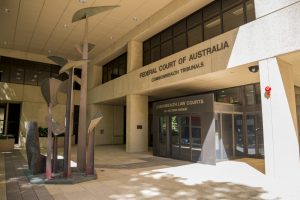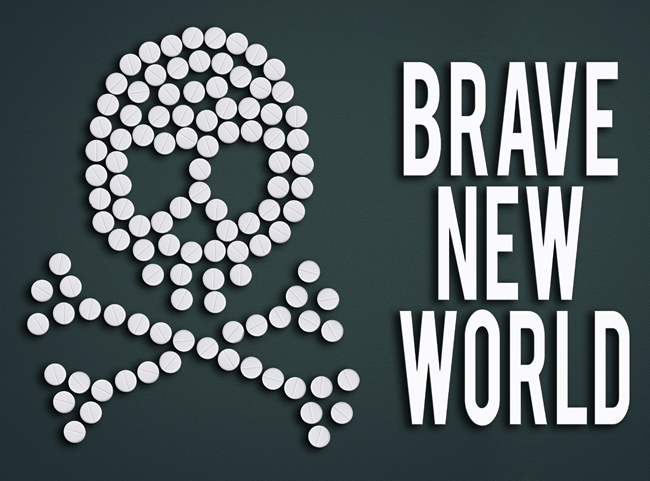While United Nations’ reports call for a revolution in mental health against coercive psychiatric practices and for forced biomedical models—drugs, electroshock—to be banned, Australia pours more money into failing youth psychiatric programs.
By Jan Eastgate
President, CCHR International
June 30, 2021
Two top “Brave New World” Australian psychiatrists, Patrick McGorry and Ian Hickey would prefer the Citizens Commission on Human Rights (CCHR) stop exposing the country’s failing mental health system, especially for youths. The two developed the Headspace youth mental health program in 2006, which has been funded with millions of taxpayer dollars since then, despite a 2015 independent study revealing a 77% failure rate in improving teens.[1]
McGorry claims psychiatrists can predict the onset of mental illness in three-year-olds.[2] All Australian children aged 0-3 are to be screened for “emotional wellness.” A recent Productivity Commission report recommended screening 1.25 million children in this age group for “mental illness” and “emerging mental illness.”[3] A percent would at risk of being drugged. If McGorry’s past practices were resurrected, they could potentially be labeled “at risk” for “mental illness” and drugged before being officially diagnosed with a disorder.[4]
Researchers believe that Headspace centers were already “becoming ‘clinical laboratories’ for applied research.”[5] An audit of prescribing practices at one Headspace clinic exposed that “the majority of young people (74.5%) were prescribed an antidepressant before an adequate trial of psychotherapy was undertaken and that less than 50% were monitored for so-called depression symptom improvement and antidepressant treatment emergent suicide related behaviors (35% and 30% respectively).[6]
The program being cited for high antidepressant use, raises questions whether this has contributed to the youth suicide rate in the country.[7]
In 2020, three Australian researchers—Martin Whitely at John Curtin Institute of Public Policy in Perth and Melissa Raven and Jon Jureidini at the University of Adelaide’s Critical and Ethical Mental Health Research Group—found the top method for self-harm and suicide in younger age groups in Australia is overdosing on antidepressants, stating: “There is clear evidence that more young Australians are taking antidepressants, and more young Australians are killing themselves and self-harming, often by intentionally overdosing on the very substances that are supposed to help them.”[8]
CCHR International’s psychiatric drug side effects database reports more than 150 drug regulatory agency warnings about antidepressants alone causing cardiovascular and other heart problems, hostility, aggression, agitation, insomnia, anxiety, sexual dysfunction and suicide.[9]
In spite of this and apparently beguiled by promises of better mental health for the country, this year, the Australian Federal government earmarked another $278.6 million in the 2021-2022 budget for ten new Headspace clinics, growing its footprint to 164 centers across Australia. This program is also to be expanded with $487 million for “Head to Health” centers, initially comprising 40 psychiatric treatment clinics for 12–24-year-olds that have “outgrown” headspace.[10] Hardly “underfunded,” which the psychiatrists have complained of, the Government’s further funding is part of their investment of $2.3 billion into the National Mental Health and Suicide Prevention Plan. The funding is said to reinforce the Government’s existing investment of $6.5 billion in mental health services in 2021-2022.[11]
Recommendations have also been made to add fifteen child mental health clinics to capture children in the 0-12 years age bracket.[12]
 From birth to young adults, Australians will be tapped into a mental health world that has traditionally relied upon an unworkable biomedical model: drugs, electroshock and newer brain-intervention methods. Yet United Nations reports and the World Health Organization’s (WHO) June 10 guideline on community mental health calls for an end to the biomedical paradigm.
From birth to young adults, Australians will be tapped into a mental health world that has traditionally relied upon an unworkable biomedical model: drugs, electroshock and newer brain-intervention methods. Yet United Nations reports and the World Health Organization’s (WHO) June 10 guideline on community mental health calls for an end to the biomedical paradigm.
The WHO report also said decades of psychiatric coercion has led to “physical and psychological harm and even death.” The guidelines identify forced electroshock treatment and psychotropic drugs as torture and calls for a ban on “forced hospitalization and forced treatment.”[13]
There has been Australian criticism of Headspace for treating Aboriginal and Torres Strait children.[14] ABC News spoke to young Australian Indigenous people who were far from impressed by headspace services. “I went twice to headspace because I had issues with depression, but they didn’t really help at all,” Cody said. “Really, to sum it all up, headspace was just a waste of time,” 14-year-old Jahnesta said.[15]
Why Brave New World?
Why are these psychiatrists equated with Brave New World, essentially identifying them with Aldous Huxley’s book about a totalitarian utopia where people were controlled by “soma” (by today’s standards, antipsychotic, antidepressant and other psychotropic drugs), even though they were not “ill”? Huxley may have written Brave New World as a satire of the society he was living in, but it holds weight today. These two psychiatrists exemplify it.
An article in Psychology Today once accused McGorry of using an “extremely inaccurate diagnosis [that] would lead to widespread treatment with an ineffective but dangerous medication [antipsychotic drugs].”[16]
That diagnosis was “Psychosis Risk Syndrome” (PRS), used to justify pre-drugging individuals—at least from the age of 14. McGorry was trumpeting it as “early intervention” and urging for it to be enshrined in the American Psychiatric Association’s Diagnostic & Statistical Manual for Mental Disorders (DSM). It drew international condemnation, just as his “Headspace youth mental health” program has in Australia.[17]
As CCHR International and others, such as Dr. Allen Francis, Professor of Psychiatry at Duke University in the U.S., revealed, the problems with PRS were 1), the identification process had a 70-90% false positive (inaccuracy) rate that could lead up to 90 out of every 100 persons being set up to be drugged and 2) antipsychotics were the drug of choice to “pre-treat” this, and they actually cause psychosis.[18]
Other side effects of antipsychotics include, hallucinations, hostility, and suicide, an irreversible neurological effect called Tardive Dyskinesia that manifests in uncontrollable twitching of the muscles and extremities and tongue movements as well as Neuroleptic malignant syndrome, which can cause sudden death. Therefore, all youths and consumers prescribed these to “prevent” psychosis were at risk of developing these debilitating effects.[19]
McGorry was thwacked by his peers. Prof. Frances, who is also the former chairman of APA’s Diagnostic and Statistical Manual of Mental Disorders fourth edition task force said that PRS “stands out as the most ill-conceived and potentially harmful” practice and the “treatment” has “definite dangerous complications.”[20]
Further, he described Australia’s investment in early intervention as a” vast untried public-health experiment.”[21]
In February 2012, Hickie addressed a Royal Australian and New Zealand College of Psychiatrists (RANZCP) Inaugural Symposium on Youth Mental Health, expanding the Brave New World theory to the elderly. He reported conducting a clinical trial that involved giving antidepressants to the elderly who are “at risk” of depression, but are not actually depressed.[22] Studies show newer antidepressants may increase the risk of serious health problems in older people compared to older pills. Selective serotonin reuptake inhibitors (SSRIs) are more likely to cause death and issues such as heart attack, stroke, falls and seizures than older tricyclic antidepressants (TCAs), according to a study published in the British Medical Journal (BMJ) in 2011.[23]
Psychiatrists’ “Blueprint” Fails to Improve Mental Health
 McGorry and Hickie were instrumental in developing a “10-year-plan” and blueprint for mental health for the Australian federal government.[24] At the time, the 2010/11 budget for Headspace was more than $19 million, with an additional $39 million for 2011/12.”[25]
McGorry and Hickie were instrumental in developing a “10-year-plan” and blueprint for mental health for the Australian federal government.[24] At the time, the 2010/11 budget for Headspace was more than $19 million, with an additional $39 million for 2011/12.”[25]
Jill Stark writing for The Age and Sydney Morning Herald in 2011 quoted Professor David Castle, head of psychiatry at Melbourne’s St Vincent’s Hospital, who said: “It’s extremely worrying that the government is listening to professional lobbyists who have a massive personal investment in the programs they’re recommending—and they are undoubtedly overstating the evidence. There’s a massive conflict of interest there.”[26]
Astonishingly, McGorry, Hickie and the former CEO of the Mental Health Council of Australia and others, made the startling admission in 2012 that psychiatrists and health authorities could not produce any outcome reports for the $5.5 billion already spent annually from past mental health budgets.[27]
But the money kept rolling in.
McGorry’s Orygen Center, a tax-deductible charity since 2001, that conducts research on youth mental health for those aged 15 to 25, had income of over $34.75 million in 2020, of which 64.21% ($22,314,427) was from government grants, while 17.44% was from donations and bequests ($6,058,994). More than 64.6% of its expenses went to employees.[28]
In 2011, mental health spending in the country had reached $2.5 billion over a five-year period, focusing on prevention and early intervention for children. Children as young as three were earmarked to undergo testing for “social and emotional wellbeing” (aka mental disorders). Headspace was to receive a lion share of federal funds—almost $200 million for 30 new Headspace centers to provide treatment for up to 72,000 12–25-year-olds each year. A further twelve youth psychosis sites were to be established to help 11,000 young people purportedly “at risk” of developing psychosis.[29]
A single national e-mental health portal and an e-clinic was also recommended at the time.[30] A site was launched in July 2012 as part of the government’s new e-Mental Health Strategy.[31] In 2017, a new portal was launched to prove “one-stop access to digital mental health services” called “Head-to-Health.” These resources include free or low-cost apps, online support communities, online courses and phone services. Digital mental health was then endorsed by Australia’s Fifth National Mental Health and Suicide Prevention Plan. And $43 million was announced in funding for national suicide prevention leadership and support activity to organizations across Australia such as R U OK?, Suicide Prevention Australia and Mindframe. [32] Mindframe is managed by Everymind, which the Australian government funds, and works with media on mental health issues.[33]
In 2017, Headspace was earmarked to receive another $92.6 million. Headspace includes eheadspace, which is another online and telephone service. Young people can speak with a psychiatrist online, based on referral from a Headspace center.[34]
In addition, $52.6 million was provided to beyondblue, a depression marketing program started in 2000, which was partnered with Headspace and Early Childhood Australia to provide tools for teachers to support kids with mental health concerns and provide resources to help students.[35] Hickie was the inaugural CEO of beyondblue between 2000 and 2003 and clinical advisor from 2003 to 2006.[36] The program is supported by the Federal Government and every State and Territory Government in Australia, as well as private funding.[37]
In January 2019, the national Liberal government said it was investing $47 million to continue supporting Headspace over several years with a new youth mental health ambassadors project and funding for its head office, claiming one in four young Australians aged 16 to 24 experience mental illness in any given year. This was only one month after it was announced that $110 million was allocated to Headspace in addition to a commitment given in October 2018 of $51.8 million—for a total investment of $208 million.[38]
The Government said it would also “be guaranteeing a stable future for Headspace centers expanding the role of Headspace National in providing support to Primary Health Networks (PHNs) with commissioning of Headspace services throughout Australia.”[39]
In other words, an avalanche of over- not under-funding!
Under these psychiatrists’ watch, how has Australia fared from their blueprint and youth services? And with a Federal budget of $10 billion spent annually on mental health.[40]
 Australia now has the fourth highest rate of antidepressant use in the world and the number of children and teens taking these have increased by almost 60% in the past five years. This is despite warnings that the drugs can induce suicide in this age group.[41]
Australia now has the fourth highest rate of antidepressant use in the world and the number of children and teens taking these have increased by almost 60% in the past five years. This is despite warnings that the drugs can induce suicide in this age group.[41]- On par with the United States, more than 1 in 6 Australians (17.2% of the Australian population or 4.4 million) filled a mental health-related prescription in 2019–20, including highly potent drugs being prescribed to those aged four and younger.[42]
- In a population of 25.4 million, there were 40.7 million prescriptions written for mind-altering psychiatric drugs in 2019/2020.[43]
- Nearly 10,000 Australian children under the age of 18 (including 300 aged 6 and younger) are being prescribed antipsychotics. There have been15 deaths linked to antipsychotics in this age group.[44]
- Suicide is still reported as the leading cause of death among people aged 15–24 (37%), followed by land transport accidents (20%). For people aged 25–44, it was also suicide (23%), followed by accidental poisoning (13%).[45] Shouldn’t the numbers be going down, given the whopping investment?
- The Productivity Commission’s Report on Government Services 2020, revealed that 2017/18 results, which, quite frankly, were appalling:
-
- 62.3% of those aged 0-17 discharged from ongoing community care did not significantly improve.
- 43.5% of this age group discharged from a psychiatric ward/facility did not significantly improve.
- 46.1% discharged from community care did not
significantly improve. - 15.1% or 15,193 of those who were admitted to psychiatric acute inpatient services were re-admitted to acute wards again within 28 days.[46]
There comes a time in any business when throwing money at a failing project in the faint hope that some return will be realized, is just plain bad business. In the case of Australian psychiatry, however, it seems money has literally been given away. There are no cures—just more disorders and more demands for funding with little, to no—if not worse—results. But the true cost is not dollars, it is people’s lives.
Former United Nations Special Rapporteur Dainius Pūras, M.D., in a recent interview with Psychiatric Times, lambasted psychiatry’s reliance on the biomedical model—liberally used in Australia. He called for a revolution in mental health care around the world away from this paradigm and to “end decades of neglect, abuse and violence” in the mental health system.
He wrote: “There is now unequivocal evidence of the failures of a system that relies too heavily on the biomedical model of mental health services, including the front-line and excessive use of psychotropic medicines, and yet these models persist.” He was “critical about the effects of totalitarian and authoritarian regimes on societal mental health and well-being.”[47] Regimes still rife in Australia.
CCHR questioned McGorry’s theories and early intervention methods more than a decade ago.
In 2010, New Dawn exposed McGorry’s “Brave New World of Pre-Drugging Kids” for the discredited “Psychosis Risk Syndrome.”[48]
Before the magazine had even published the article, emails were circling the psychiatric wagon, as discovered in records obtained through a Freedom of Information Act request in 2010. The emails were between McGorry and others—the names were redacted from the documents. An email dated August 2, 2010, said a “representative of the… (Citizens Commission on Human Rights) was interviewed” at a psychiatric conference and mentioned the upcoming expose on “Pat and the Psychosis Risk Syndrome.” This was followed by an email on March 10, about CCHR being a “a major threat to the credibility of mental health interventions.”[49]
Saving lives from coercive and enforced treatment is vital. Children don’t have the right to consent, which, essentially constitutes forced treatment, that UN bodies treat as torture. Parents, seeking the best care for their kids and in consenting on their behalf, are notoriously misinformed about the risks of these treatments.
CCHR will continue to expose dangerous “mental health interventions,” especially in light of the WHO report. And, especially when these are being fed millions, if not billions of dollars by unwitting policy makers using taxpayer dollars. Add to that psychiatry or “mental health’s” additional hefty funding from pharmaceutical companies. CCHR’s actions are important because, as Dr. Pūras says: “…the problem of accountability in global mental health and psychiatry remains very serious.”[50]
Psychiatrists answer to any criticism is to attack the messenger, criticizing even Dr. Pūras of being “anti-psychiatry,” as if this is something pernicious rather than necessary.
Three authors, including a professor of psychology explained this phenomenon to colleagues, saying that when the label of “anti-psychiatry” is thrown at you, “remember that this is the way defensive and rigidly biological psychiatrists often respond to people and ideas that frighten them: apply a negative label and pretend the label is an explanation.”[51]
Retired psychologist Philip Hickey Ph.D. elaborates on this: “They won’t acknowledge their errors. They won’t back down. And they won’t stop, or even curtail, their destructive practices. They will not even seriously debate the issues. Instead, they’ve gone on the offensive. This offensive is two-pronged. Firstly, they attack those of us who speak out against them, and secondly, they are actively developing links to the media in the hopes that this will encourage reporters to portray them in a more favorable light.”[52]
McGorry and Hickie take umbrage about fliers and other materials CCHR has produced, crying they are defamatory. But looking at examples of this and you find that these fliers expose their conflicts of interest that is a standard requirement in medicine today to disclose.
- “Patrick McGorry: Professor of Youth Mental Health at the University of Melbourne, Australia is speaking about Youth Mental Health, yet he came under international criticism for claiming that individuals, including adolescents aged 14, could be drugged with antipsychotics to “prevent” on the onset of psychosis. A leading U.S. professor of psychiatry, Allen Frances, called it a “reckless experiment in early intervention.”[53] In August 2011, a group of 13 international health experts lodged a complaint about McGorry’s AstraZeneca-funded trial of the antipsychotic drug, Seroquel, on children who were “at risk of psychosis.” The experts accused the trial of being unethical. Prof. McGorry aborted the study. AstraZeneca recently paid $647 million to settle a lawsuit, alleging there was insufficient warning that Seroquel may cause diabetes. Prof. McGorry is a consultant for Janssen Cilag, Eli Lilly, Pfizer and has received grant/research support from Janssen-Cilag, AstraZeneca, BMS, Eli Lilly, Pfizer, and Novartis.”[54]
- Professor Ian Hickie has served on the professional advisory boards convened by drug industry in relation to specific antidepressants made by Bristol-Myers Squibb (BMS) and Eli Lilly and has led projects funded in part by BMS, Pfizer, Eli Lilly, Wyeth and Servier.[55] He is a member of the peer review committee of the National Health and Medical Research Council (NHMRC), which says there’s “an emerging body of evidence on the use of hallucinogens or stimulant drugs supported by psychological/psychiatric care for treatment resistant mental illness.”[56]
It’s all public record information—hardly defamation.
 Whenever CCHR has exposed particularly rotten spots in psychiatry’s history, there have been attempts to silence it. In Australia, CCHR obtained a ban on lethal deep sleep treatment (DST) under Mental Health Acts. The “treatment” involved patients being knocked unconscious for several weeks with a cocktail of drugs while being electroshocked—killing 48 people. The Sydney Morning Herald published a ground-breaking “Psychiatry Gone Mad” series in 1988 that CCHR and the DST survivors worked with the Herald reporters on.[57] A NSW Royal Commission inquiry into DST was subsequently held, which acknowledged CCHR’s pivotal role in getting the disastrous treatment banned.
Whenever CCHR has exposed particularly rotten spots in psychiatry’s history, there have been attempts to silence it. In Australia, CCHR obtained a ban on lethal deep sleep treatment (DST) under Mental Health Acts. The “treatment” involved patients being knocked unconscious for several weeks with a cocktail of drugs while being electroshocked—killing 48 people. The Sydney Morning Herald published a ground-breaking “Psychiatry Gone Mad” series in 1988 that CCHR and the DST survivors worked with the Herald reporters on.[57] A NSW Royal Commission inquiry into DST was subsequently held, which acknowledged CCHR’s pivotal role in getting the disastrous treatment banned.
The practice of DST at Chelmsford private psychiatric hospital was called one of the darkest periods in Australian psychiatry’s history. McGorry and Hickie’s plans to drug patients “at risk” of psychosis or depression provided a whole new meaning to “Psychiatry gone mad.”
CCHR obtained the first informed consent to treatment under State Mental Health Acts—when psychiatrists didn’t think it necessary; it helped protect minors from electroshock treatment by getting it banned in Western Australia; it obtained an inquiry into brain-damaging psychosurgery, which was also banned in NSW, to name but a few of its accomplishments that helped to save lives.
The late Dr. John Ellard was an influential psychiatrist, who served as editor of Modern Medicine, now called Medicine Today, Chair of the Law Foundation of NSW for two decades and recipient of a medal of honour from the RANZCP.[58] In November 1994, he criticized the lack of action taken over deep sleep treatment and Ward 10B, in Queensland, where a modified version of deep sleep was administered, also killing patients. He said that health departments did very little “and what they did was useless…. The Medical Board of Queensland said of the events of Ward 10B that they could see no grounds for the laying of criminal charges and that was the end of it,” he added. But Ellard believed there were grounds.
Probably to the chagrin of McGorry and Hickie today, Ellard told a Sydney conference in 1994 that the Church of Scientology [which established CCHR in 1969] was an important player in both cases, “starting more action than all the boards, departments and coronial inquiries had done.”[59]
It remains the case today.
Peter Birleson, former director of mental health services at Melbourne’s Royal Children’s Hospital, once stated: “The McGorry machine is distorting things in Australia. There’s people in the UK who look at what’s happening in adolescent and youth psychiatry here and think that it’s completely mad.”[60]
According to ABC News, after years of government investment in Headspace, doctors, social workers and former clients urged the Australian Government to stop opening new clinics and consider the shortcomings of the model. [61] Clearly, the government has not listened.
CCHR will continue to make these demands and do its part in the revolution in mental health care needed around the world that Dr. Pūras called for in order to “end decades of neglect, abuse and violence.” Australia has been a breeding ground for this and it’s time for, as the WHO report, says, an eradication of coercive and harmful psychiatric practices. Governments need to stop revering and funding those psychiatrists that are causing the problem.
References:
[1] “Is headspace making a difference to young people’s lives: Final report on the independent evaluation of the headspace program, UNSW, Prepared for the Australian Government, 2015, pp. 2,3; https://espace.curtin.edu.au/handle/20.500.11937/54297
[2] https://www.cchrint.org/2019/12/19/cchr-warns-of-psychiatrist-patrick-mcgorry-others-brave-new-world/#_edn5 citing: “Mental health testing planned for three-year-olds as part of early intervention program: EVERY three-year-old child could have their mental health tested under an ambitious program designed to catch problems early,” News.com.au, https://www.news.com.au/national/mental-health-testing-planned-for-three-year-olds-as-part-of-early-intervention-program/news-story/a48fd340d2ed6d7a1c1195eca8489921
[3] https://cchr.org.au/0-3-year-olds-to-be-screened-for-mental-illness, citing: Productivity Commission Mental Health Inquiry Final Report, Volume 2, No. 95, 30 June 2020, released on 16 November 2020, pp. 197-198, 203, https://www.pc.gov.au/inquiries/completed/mental-health/report/mental-health-volume2.pdf
[4] https://www.theguardian.com/australia-news/2021/may/11/budget-2021-mental-health-package-reform-adult-youth-child-headspace-head-to-health-clinics-suicide-prevention-services-australia-federal
[5] Kelly Patricia O’Meara, “Drugging Kids in Anticipation of Future Mental Disorders? Australian Psychiatrist Patrick McGorry, Focus on Soaring Antipsychotic Use in Aussie Youths,” CCHR International, 28 Apr. 2015, https://www.cchrint.org/2015/04/27/drugging-kids-patrick-mcgorry/
[6] https://www.cchrint.org/2020/07/14/group-warns-parents-that-eugenics-is-being-repackaged-as-mental-health-care/ citing: Martin Whitely, et al., “Antidepressant Prescribing and Suicide/Self-Harm by Young Australians: Regulatory Warnings, Contradictory Advice, and Long-Term Trends,” Frontiers in Psychiatry, 5 June 2020, https://www.frontiersin.org/articles/10.3389/fpsyt.2020.00478/full
[7] https://www.cchrint.org/2020/07/14/group-warns-parents-that-eugenics-is-being-repackaged-as-mental-health-care/ citing: Martin Whitely, et al., “Antidepressant Prescribing and Suicide/Self-Harm by Young Australians: Regulatory Warnings, Contradictory Advice, and Long-Term Trends,” Frontiers in Psychiatry, 5 June 2020, https://www.frontiersin.org/articles/10.3389/fpsyt.2020.00478/full
[8] https://www.cchrint.org/2020/12/15/cchr-hails-australias-study-of-antidepressant-link-to-youth-suicide/#_edn9, citing: https://bigthink.com/surprising-science/antidepressants-suicide?rebelltitem=1#rebelltitem1, citing: “Antidepressant Prescribing and Suicide/Self-Harm by Young Australians: Regulatory Warnings, Contradictory Advice, and Long-Term Trends,” Frontiers in Psychiatry, 5 June 2020, https://www.frontiersin.org/articles/10.3389/fpsyt.2020.00478/full
[9] https://www.cchrint.org/2020/05/05/cchr-international-warns-about-brave-new-world-in-psychiatric-research-trends/
[10] https://www.theguardian.com/australia-news/2021/may/11/budget-2021-mental-health-package-reform-adult-youth-child-headspace-head-to-health-clinics-suicide-prevention-services-australia-federal; https://rpassistants.com.au/news/funding-boost-for-headspace-services/
[11] https://rpassistants.com.au/news/funding-boost-for-headspace-services/
[12] https://www.theguardian.com/australia-news/2021/may/11/budget-2021-mental-health-package-reform-adult-youth-child-headspace-head-to-health-clinics-suicide-prevention-services-australia-federal
[13] https://www.cchrint.org/2021/06/11/world-health-organization-new-guidelines-are-vital-to-end-coercive-psychiatric-practices-abuse/ citing: “Guidance on Community Mental Health Services: Promoting Person-Centered and Rights-Based Approaches,” World Health Organization, 10 June 2021, pp 4, 8, https://www.who.int/publications/i/item/9789240025707 (to download report)
[14] https://www.cchrint.org/2020/07/14/group-warns-parents-that-eugenics-is-being-repackaged-as-mental-health-care/#_edn9, citing: https://med.stanford.edu/content/dam/sm/psychiatry/documents/initiatives/allcove/headspacepilotoverview.pdf
[15] https://www.cchrint.org/2020/07/14/group-warns-parents-that-eugenics-is-being-repackaged-as-mental-health-care/#_edn10, citing https://www.cchrint.org/2020/07/14/group-warns-parents-that-eugenics-is-being-repackaged-as-mental-health-care/#_edn6 citing: “Headspace is ‘easy for politicians’, but failing Australia’s youth, experts say,” ABC News, 27 Aug. 2019, https://www.abc.net.au/news/2019-04-28/headspace-failing-australias-youth-experts-say/11039776
[16] https://www.cchrint.org/2020/05/05/cchr-international-warns-about-brave-new-world-in-psychiatric-research-trends/ citing: https://www.psychologytoday.com/us/blog/dsm5-in-distress/201007/psychosis-risk-syndrome-just-risky-new-name
[17] https://www.cchrint.org/2020/07/14/group-warns-parents-that-eugenics-is-being-repackaged-as-mental-health-care/ citing: Martin Whitely, et al., “Antidepressant Prescribing and Suicide/Self-Harm by Young Australians: Regulatory Warnings, Contradictory Advice, and Long-Term Trends,” Frontiers in Psychiatry, 5 June 2020, https://www.frontiersin.org/articles/10.3389/fpsyt.2020.00478/full
[18] Allen Frances, M.D., “DSM5 ‘Psychosis Risk Syndrome’–Far Too Risky,” Psychology Today, http://www.psychologytoday.com/blog/dsm5-in-distress/201003/dsm5-psychosis-risk-syndrome-far-too-risky.
[19] https://www.cchrint.org/2020/05/05/cchr-international-warns-about-brave-new-world-in-psychiatric-research-trends/#_edn1
[20] https://www.cchrint.org/2010/05/21/meet-the-psychiatrist-pushing-for-a-brave-new-world-of-pre-drugging-kids-patrick-mcgorry/
[21] https://www.cchrint.org/2011/08/06/former-australian-of-the-year-psychiatrist-patrick-mcgorry-accuses-of-conflict-of-interest/ citing: Jill Stark, “McGorry accused of conflict of interest,” Sydney Morning Herald (also ran in The Age),7 Aug. 2011, https://www.smh.com.au/national/mcgorry-accused-of-conflict-of-interest-20110806-1igxd.html#ixzz1UGsdyj2v
[22] https://cchr.org.au/melbourne-symposium-on-youth-mental-health-transition-into-adulthood-conflicts-of-interest-putting-millions-of-childrens-lives-at-risk
[23] “Warning over newer antidepressants pills,” The Independent, 23 Oct. 2011, https://www.independent.co.uk/life-style/health-and-families/health-news/warning-over-newer-antidepressants-pills-2331030.html
[24] “Australia’s ‘Draft Ten Year Roadmap for Mental Health Reform,’” CCHR Australia, January 2012, https://cchr.org.au/australias-draft-ten-year-roadmap-for-mental-health-reform
[25] Kelly Patricia O’Meara, “Drugging Kids in Anticipation of Future Mental Disorders? Australian Psychiatrist Patrick McGorry, Focus on Soaring Antipsychotic Use in Aussie Youths,” CCHR International, 28 Apr. 2015, https://www.cchrint.org/2015/04/27/drugging-kids-patrick-mcgorry/
[26] https://www.cchrint.org/2011/08/06/former-australian-of-the-year-psychiatrist-patrick-mcgorry-accuses-of-conflict-of-interest/ citing: Jill Stark, “McGorry accused of conflict of interest,” Sydney Morning Herald (also ran in The Age),7 Aug. 2011, https://www.smh.com.au/national/mcgorry-accused-of-conflict-of-interest-20110806-1igxd.html#ixzz1UGsdyj2v
[27] “Australia’s ‘Draft Ten Year Roadmap for Mental Health Reform,’” CCHR Australia, January 2012, https://cchr.org.au/australias-draft-ten-year-roadmap-for-mental-health-reform
[28] https://www.acnc.gov.au/charity/a96ce70490b814e02afc91d68e66668d; https://www.acnc.gov.au/charity/a96ce70490b814e02afc91d68e66668d#ais-8e351b3ebab432a41ceef5f03662d934
[29] http://blogs.crikey.com.au/croakey/2011/05/10/overview-of-the-budgets-mental-health-announcements-and-some-preliminary-reaction/; https://www.dailytelegraph.com.au/sanity-prevails-as-mental-health-care-dominates/news-story/1ec63198be9618796d3e540fb2526b4b
[30] https://archive.budget.gov.au/2011-12/bp2/bp2.pdf
[31] https://www.aihs.org.au/news-and-publications/news/national-e-mental-health-portal
[32] https://opengovasia.com/new-portal-from-australian-government-provides-one-stop-access-to-digital-mental-health-services/
[33] https://mindframe.org.au/about-us/advisory-groups/mindframe-social-media-advisory-group
[34] https://opengovasia.com/new-portal-from-australian-government-provides-one-stop-access-to-digital-mental-health-services/
[35] https://opengovasia.com/new-portal-from-australian-government-provides-one-stop-access-to-digital-mental-health-services/
[36] https://seriouslysocial.org.au/contributor/ian-hickie/
[37] https://www.beyondblue.org.au/about-us/who-we-are-and-what-we-do/our-funding
[38] “$47 million for headspace to support youth mental health,” Greg Hunt, Minister for Health and Aged Care, Department of Health, 9 Jan 2019, https://www.health.gov.au/ministers/the-hon-greg-hunt-mp/media/47-million-for-headspace-to-support-youth-mental-health
[39] Ibid.
[41] https://www.cchrint.org/2019/12/19/cchr-warns-of-psychiatrist-patrick-mcgorry-others-brave-new-world/#_edn6, citing https://www.smh.com.au/lifestyle/nearly-one-in-10-australians-take-antidepressants-are-there-other-solutions-20180116-h0jaxx.html; “10. PHARMACEUTICAL SECTOR – Pharmaceutical consumption,” Health at a Glance 2019: OECD Indicators, The Organisation for Economic Co-operation and Development, p. 211, https://www.oecd.org/health/health-systems/health-at-a-glance-19991312.htm
[42] Sara G. Miller “1 in 6 Americans Takes a Psychiatric Drug,” Scientific American, 13 Dec. 2016, https://www.scientificamerican.com/article/1-in-6-americans-takes-a-psychiatric-drug/
[44] https://cchr.org.au/melbourne-symposium-on-youth-mental-health-transition-into-adulthood-conflicts-of-interest-putting-millions-of-childrens-lives-at-risk
[45] https://www.aihw.gov.au/reports/life-expectancy-death/deaths-in-australia/contents/leading-causes-of-death
[46] https://cchr.org.au/0-3-year-olds-to-be-screened-for-mental-illness citing: “Table 13A.62 – People who received mental health care provided by State and Territory public mental health services and who significantly improved, by service type and age group (per cent) (a), (b), (c),” and “Table 13A.34 – Readmissions to hospital within 28 days of discharge (a), (b), (c),” Mental health management — Data tables contents, Report on Government Services 2020, https://www.pc.gov.au/research/ongoing/report-on-government-services/2020/health/mental-health-management/rogs-2020-parte-section13-data-tables.xlsx
[47] https://www.cchrint.org/2021/06/07/un-special-rapporteur-dainius-puras-addresses-psychiatrys-global-coercion-crisis/ citing: Awais Aftab, MD, “Global Psychiatry’s Crisis of Values: Dainius Pūras, MD,” Psychiatric Times, 3 June 2021, https://www.psychiatrictimes.com/view/global-psychiatry-crisis-values; https://www.cchrint.org/2021/03/08/resource-on-why-psychiatry-is-upset-about-its-failures-and-critics/, citing: “World needs ‘revolution’ in mental health care – UN rights expert,” 2017, http://www.ohchr.org/EN/NewsEvents/Pages/DisplayNews.aspx?NewsID=21689&LangID=E#sthash.MMIxDbIx.dpuf; A/HRC/35/21, “Promotion and protection of all human rights, civil, political, economic, social and cultural rights, including the right to development,” Report of the Special Rapporteur on the right of everyone to the enjoyment of the highest attainable standard of physical and mental health, Human Rights Council Thirty-fifth session, Agenda item 3, 6-23 June 2017, available at: https://digitallibrary.un.org/record/1298436?ln=en
[48] https://www.cchrint.org/2010/07/08/new-dawn-magazine-the-brave-new-world-of-pre-drugging-kidspatrick-mcgorry-psychosis-risk-syndrome-by-jan-eastgate/
[49] FOIA email obtained, citing email August 2, 2:34 p.m. (pp. 97, 113-114) From: [blacked out] To [blacked out] McGorry [blacked out] Subject: “FYI –Church of Scientology and IYMH [International Youth Mental Health conference”
[50] https://www.cchrint.org/2021/06/07/un-special-rapporteur-dainius-puras-addresses-psychiatrys-global-coercion-crisis/ citing: Awais Aftab, MD, “Global Psychiatry’s Crisis of Values: Dainius Pūras, MD,” Psychiatric Times, 3 June 2021, https://www.psychiatrictimes.com/view/global-psychiatry-crisis-values and “World needs ‘revolution’ in mental health care – UN rights expert,” 2017, http://www.ohchr.org/EN/NewsEvents/Pages/DisplayNews.aspx?NewsID=21689&LangID=E#sthash.MMIxDbIx.dpuf; A/HRC/35/21, “Promotion and protection of all human rights, civil, political, economic, social and cultural rights, including the right to development,” Report of the Special Rapporteur on the right of everyone to the enjoyment of the highest attainable standard of physical and mental health, Human Rights Council Thirty-fifth session, Agenda item 3, 6-23 June 2017, available at: https://digitallibrary.un.org/record/1298436?ln=en
[51] https://www.cchrint.org/2021/03/08/resource-on-why-psychiatry-is-upset-about-its-failures-and-critics/ citing, John Read, Olga Runciman, Cand Psych BSc & Jacqui Dillon, “In Search of an Evidence-based Role for Psychiatry,” Mad in America, 28 Mar. 2016, https://www.madinamerica.com/2016/03/in-search-of-an-evidence-based-role-for-psychiatry-2/
[52] https://www.cchrint.org/2021/03/08/resource-on-why-psychiatry-is-upset-about-its-failures-and-critics/#_edn4 citing, Phillip Hickey, Ph.D., “Psychiatry’s Response: Attack and PR,” Scientific American, 18 June 2014, https://www.madinamerica.com/2014/06/psychiatrys-response-attack-pr/
[53] “Australia’s Reckless Experiment In Early Intervention,” Psychology Today, 31 May 2011, http://www.psychologytoday.com/blog/dsm5-in-distress/201105/australias-reckless-experiment-in-early-intervention
[54] CCHR flier produced for distribution outside the World Psychiatric Association World Congress, Spain, 2014
[55] https://www.cchrint.org/2017/03/15/patrick-mcgorry-plans-to-dope-12yearolds-with-cannabis/#_edn24 citing: Ian Hickie, “Is depression over diagnosed? No,” British Medical Journal, 18 Aug. 2007, https://www.ncbi.nlm.nih.gov/pmc/articles/PMC1949449/
[56]“MRFF – 2021 Innovative Therapies For Mental Illness Grant Opportunity,” NHMRC, https://www.nhmrc.gov.au/funding/find-funding/mrff-2021-innovative-therapies-mental-illness-grant-opportunity-go-id-4726
[57] John O’Neill and Robert Haupt, “Psychiatry Gone Mad: ‘We Want Justice,’” The Sydney Morning Herald, 30 July,1988
[58] https://medicinetoday.com.au/2011/november/regular-series/dr-john-ellard-am-1924%E2%80%932011
[59] Leone Marten, “The Three Learned Professions have Disgraceful Records: Expert Exploit,” AAP wire, 18 Nov. 1994
[60] https://www.cchrint.org/2011/08/06/former-australian-of-the-year-psychiatrist-patrick-mcgorry-accuses-of-conflict-of-interest/ citing: Jill Stark, “McGorry accused of conflict of interest,” Sydney Morning Herald (also ran in The Age),7 Aug. 2011, https://www.smh.com.au/national/mcgorry-accused-of-conflict-of-interest-20110806-1igxd.html#ixzz1UGsdyj2v
[61] https://www.cchrint.org/2020/07/14/group-warns-parents-that-eugenics-is-being-repackaged-as-mental-health-care/#_edn10, citing https://www.cchrint.org/2020/07/14/group-warns-parents-that-eugenics-is-being-repackaged-as-mental-health-care/#_edn6 citing: “Headspace is ‘easy for politicians’, but failing Australia’s youth, experts say,” ABC News, 27 Aug. 2019, https://www.abc.net.au/news/2019-04-28/headspace-failing-australias-youth-experts-say/11039776



SHARE YOUR STORY/COMMENT